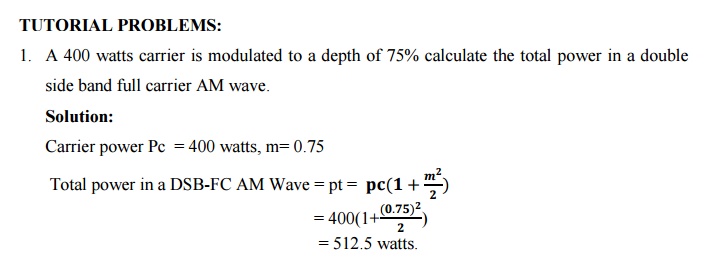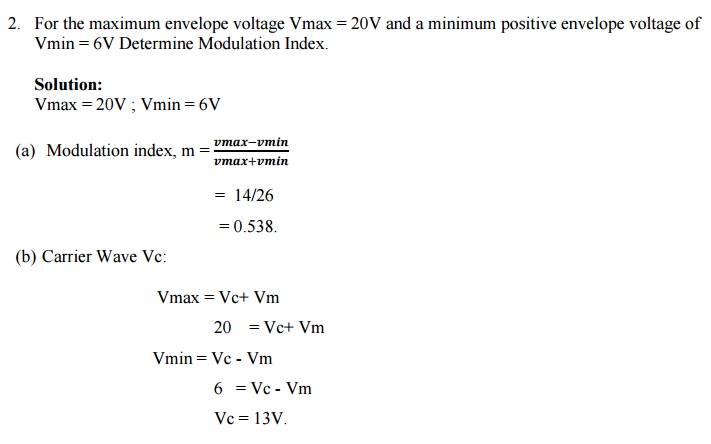Chapter: Communication Theory : Amplitude Modulation
Important Short Questions and Answers: Amplitude Modulation
AMPLITUDE
MODULATION SYSTEMS
1. Define modulation?
Modulation
is a process by which some characteristics of high frequency carrier signal is
varied in accordance with the instantaneous value of the modulating signal.
2. What are the types of analog modulation?
ü Amplitude
modulation.
ü Angle
Modulation
§ Frequency
modulation
§ Phase
modulation.
3. Define depth of modulation.
It is
defined as the ratio between message amplitude to that of carrier amplitude.
m=Em/Ec
4. What are the degrees of modulation?
·
Under modulation. m<1
·
Critical modulation m=1
·
Over modulation m>1
5. What is the need for modulation?
Ø Needs for modulation:
Ø Ease of transmission
Ø Multiplexing
Ø Reduced noise
Ø Narrow bandwidth
Ø Frequency assignment
Ø Reduce the equipments limitations
6. What are the types of AM modulators?
There are
two types of AM modulators. They are
ü Linear
modulators
ü Non-linear
modulators
Linear
modulators are classified as follows
·
Transistor modulator
There are
three types of transistor modulator.
·
Collector modulator
·
Emitter modulator
·
Base modulator
·
Switching modulators
Non-linear
modulators are classified as follows
·
Square law modulator
·
Product modulator
·
Balanced modulator
7.
What is
the difference between high level and low level modulation?
In high
level modulation, the modulator amplifier operates at high power levels and
delivers power directly to the antenna. In low level modulation, the modulator
amplifier performs modulation at relatively low power levels. The modulated
signal is then amplified to high power level by class B power amplifier. The
amplifier feeds power to antenna.
Detection
is the process of extracting modulating signal from the modulated carrier.
Different types of detectors are used for different types of modulations.
9. Define Amplitude Modulation.
In
amplitude modulation, the amplitude of a carrier signal is varied according to
variations in amplitude of modulating signal.
The AM
signal can be represented mathematically as, eAM = (Ec + Em sinωmt ) sinωct and
the modulation index is given as,m = Em /EC (or) Vm/Vc
10. What is Super Heterodyne Receiver?
The super
heterodyne receiver converts all incoming RF frequencies to a fixed lower
frequency, called intermediate frequency (IF). This IF is then amplitude and
detected to get the original signal.
11. What is single tone and multi tone modulation?
If
modulation is performed for a message signal with more than one frequency
component then the modulation is called multi tone modulation.
If
modulation is performed for a message signal with one frequency component then
the modulation is called single tone modulation.
12. Compare AM with DSB-SC and SSB-SC.

13.
What are
the advantages of VSB-AM?
1. It has bandwidth greater than SSB but less than DSB system.
2. Power transmission greater than DSB but less than SSB system.
3. No low frequency component lost. Hence it avoids phase distortion.
14. How will you generating DSBSC-AM?
There are
two ways of generating DSBSC-AM such as
a).Balancedmodulator
b).Ring
modulators.
15. What are advantages of ring modulator? a).Its
output is stable.
b). It
requires no external power source to activate the diodes. c).Virtually no
maintenance.
d). Long
life.
16. Define Demodulation.
Demodulation
or detection is the process by which modulating voltage is recovered from the
modulated signal. It is the reverse process of modulation. The devices used for
demodulation or detection are called demodulators or detectors. For amplitude
modulation, detectors or demodulators are categorized as,
a) Square-law
detectors
b) Envelope
detectors
17. Define Multiplexing.
Multiplexing
is defined as the process of transmitting several message signals
Simultaneously over a single channel.
18. Define Frequency Division Multiplexing.
Frequency
division multiplexing is defined as many signals are transmitted simultaneously
with each signal occupying a different frequency slot within a common
bandwidth.
19. Define Guard Band.
Guard
Bands are introduced in the spectrum of FDM in order to avoid any interference
between the adjacent channels. Wider the guard bands, Smaller the interference.
20.
Define
SSB-SC.
(i) SSB-SC
stands for Single Side Band Suppressed Carrier
(ii) When only
one sideband is transmitted, the modulation is referred to as Single side band
modulation. It is also called as SSB or SSB-SC.
21.
Define
DSB-SC.
After
modulation, the process of transmitting the sidebands (USB, LSB) alone and
suppressing the carrier is called as Double Side Band-Suppressed Carrier.
22.
What are
the disadvantages of DSB-FC?
(i) Power
wastage takes place in DSB-FC
(ii) DSB-FC is
bandwidth inefficient system.
23.
Define
Coherent Detection.
During
Demodulation carrier is exactly coherent or synchronized in both the frequency
and phase, with the original carrier wave used to generate the DSB-SC wave.
This
method of detection is called as coherent detection or synchronous detection.
24. What is Vestigial Side Band Modulation?
Vestigial
Sideband Modulation is defined as a modulation in which one of the sideband is
partially suppressed and the vestige of the other sideband is transmitted to
compensate for that suppression.
25.
What are
the advantages of signal sideband transmission?
a) Power
consumption
b) Bandwidth
conservation
c) Noise
reduction
26.
What are
the disadvantages of single side band transmission?
a) Complex
receivers: Single side band systems require more complex and expensive
receivers thn conventiaonal AM transmission.
b) Tuning
difficulties: Single side band receivers require more complex and precise tunig
than conventional AM receivers.
27. Compare linear and non-linear modulators?
Linear Modulators
1. Heavy
filtering is not required.
2. These
modulators are used in high level modulation.
3. The
carrier voltage is very much greater than modulating signal voltage.
Non Linear Modulators
1. Heavy
filtering is required.
2. These
modulators are used in low level modulation.
3. The
modulating signal voltage is very much greater than the carrier signal voltage.
28. What is frequency translation?
Suppose
that a signal is band limited to the frequency range extending from a frequency
f1 to a frequency f2. The process of frequency translation is one in which the
original signal is replaced with a new signal whose spectral range extends from
f1‘ and f2‘ and which new signal bears, in recoverable form the same
information as was borne by the original signal.
29.
What are
the two situations identified in frequency translations?
a) Up
Conversion: In this case the translated carrier frequency is greater than the
incoming carrier
b) Down
Conversion: In this case the translated carrier frequency is smaller than the
increasing carrier frequency.
Thus, a
narrowband FM signal requires essentially the same transmission bandwidth
as the AM signal.
30. What is BW for AM wave?
The difference between these two extreme
frequencies is equal to the bandwidth of the AM wave.
Therefore, Bandwidth, B = (fc + fm) - (fc -
fm) B = 2fm
31. What is the BW of DSB-SC signal?
Bandwidth, B = (fc + fm) - (fc - fm) B = 2f
It is obvious that the bandwidth of DSB-SC
modulation is same as that of general AM waves.
32. What are the demodulation methods for DSB-SC
signals?
The
DSB-SC signal may be demodulated by following two methods:
(i)
Synchronous detection method.
(ii)Using
envelope detector after carrier reinsertion.
33.
Write the
applications of Hilbert transform?
(i) For
generation of SSB signals,
(ii) For
designing of minimum phase type filters,
(iii) For
representation of band pass signals.
34.
What are
the methods for generating SSB-SC signal?
SSB-SC
signals may be generated by two methods as under:
(i)Frequency
discrimination method or filter method.
(ii)Phase
discrimination method or phase-shift method.



GLOSSARY TERMS:
1. Amplitude modulation: The
modulation of a wave by varying its amplitude, used especially as a means of
broadcasting an audio signal by combining it with a radio carrier wave.
2. The modulation index: (modulation
depth) of a modulation scheme describes by how much the modulated variable of
the carrier signal varies around its unmodulated level.
3. NarrowbandFM: If the modulation index of FM is
kept under 1, then the FM produced is regarded as narrow band FM.
4. Frequency modulation (FM): the
encoding of information in a carrier wave by varying the instantaneous
frequency of the wave.
5. Amplication: The level is carefully chosen so
that it does not overload the mixer when strong signals are present, but
enables the signals to be amplified sufficiently to ensure a good signal to
noise ratio is achieved.
6. Modulation: The process by which some of the
characteristics of carrier wave is varied in accordance with the message
signal.
Related Topics